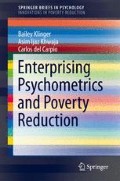Abstract
Industrial and Organizational Psychology has developed tools to solve a similar problem: personnel selection. Big companies need to select among a large number of individuals applying for a job. This has to be done with relatively low transaction costs, and there is little information available to separate the good candidates from the bad candidates—a very similar problem to that facing the banks. Psychologists have developed psychometric tools to measure things like personality, motivation, outlook, and intelligence, which are related to subsequent job performance. These tools have been shown to work even better than other methods like interviews and background checks, and are widely used. What if they could be applied to the selection of small businesses to lend to? We review a variety of academic studies that have already used these tools to evaluate entrepreneurs and distinguish entrepreneurs from non-entrepreneurs and good entrepreneurs from bad entrepreneurs. The studies center on three main themes: personality, intelligence, and honesty. The first two relate to the ability to repay a loan, in that they could identify entrepreneurs who are more likely to successfully grow their business and its cash flows. Honesty relates to the willingness to repay a loan, as banks need to worry not just if the entrepreneur has enough money to repay but if they then decide to repay or else take the money and run. These studies provide initial insight into what particular characteristics and abilities could be systematically related to credit risk, and used for future lending to small business owners who would traditionally be rejected by banks due to a lack of information.
Access this chapter
Tax calculation will be finalised at checkout
Purchases are for personal use only
References
American Management Association. (2001). 2001 AMA survey on workplace testing: basic skills, job skills, and psychological measurement. New York: American Management Association.
Barrick, M., & Mount, M. (1991). The Big Five personality dimensions and job performance: a meta-analysis. Personnel Psychology, 44, 1–26.
Bernardin, H., & Cooke, D. (1993). Validity of an honesty test in predicting theft among convenience store employees. The Academy of Management Journal, 36(5), 1097–1108.
Cable, D., & Shane, S. (1997). A prisoner’s dilemma approach to entrepreneur-venture capitalist relationships. Academy of Management Review, 22(1), 142–176.
Chell, E. (2008). The entrepreneurial personality: a social construction. London: Routledge.
Ciavarella, M., Buchholtz, A., Riordan, C., Gatewood, R., & Stokes, G. (2004). The Big Five and venture survival: Is there a linkage? Journal of Business Venturing, 19, 465–483.
De Mel, S., McKenzie, D., & Woodruff, C. (2008). Returns to capital in microenterprises: evidence from a field experiment. The Quarterly Journal of Economics, 123(4), 1329–1372.
De Mel, S., McKenzie, D., & Woodruff, C. (2010). Who are the microenterprise owners? Evidence from Sri Lanka on Tokman versus De Soto. In J. Lerner & A. Schoar (Eds.), International differences in entrepreneurship (pp. 63–87). Chicago, IL: University of Chicago Press.
Djankov, S., Miguel, E., Qian, Y., Roland, G., & Zhuravskaya, E. (2005). Who are Russia’s entrepreneurs? Journal of the European Economic Association, 3(2–3), 587–597.
Djankov, S., Qian, Y., Roland, G., & Zhuravskaya, E. (2007). What makes a successful entrepreneur? Evidence from Brazil. Russia: Center for Economic and Financial Research Working Paper 0104.
Gartner, W. (1989). 'Who is an entrepreneur?’ Is the wrong question. Entrepreneurship Theory and Practice, 12(2), 47–68.
Gottfredson, G., Jones, E., & Holland, J. (1993). Personality and vocational interests: the relation of Holland’s size interest dimensions to five robust dimensions of personality. Journal of Counseling Psychology, 40, 518–524.
Handler, C. (2008, May). Results from 5th annual rocket-hire online screening and assessment usage survey. Journal of Corporate Recruiting Leadership
Holland, J. (1985). Making vocational choices. A theory on vocational personalities and work environments. Englewood Cliffs, NJ: Prentice-Hall.
Judge, T., Higgins, C., Thoresen, C., & Barrick, M. (1999). The Big Five personality traits, general mental ability, and career success across the life span. Personnel Psychology, 52(3), 621–652.
McClelland, D. (1961). The achieving society. Princeton, NJ: Van Nostrand.
Rauch, A., & Frese, M. (2007). Let’s put the person back into entrepreneurship research: a meta-analysis on the relationship between business owners’ personality traits, business creation and success. European Journal of Work and Organizational Psychology, 16(4), 353–385.
Schmidt, F., & Hunter, J. (1998). The validity and utility of selection methods in personnel psychology: practical and theoretical implications of 85 years of research findings. Psychological Bulletin, 124(2), 262–274.
Schweizer, K., Goldhammer, F., Rauch, W., & Moosbrugger, H. (2007). On the validity of Raven’s matrices test: does spatial ability contribute to performance? Personality and Individual Differences, 43, 1998–2010.
Shaver, K. (1995). The entrepreneurial personality myth. Business & Economic Review, 41(30), 20–23.
Shaver, K. (2007). C2D2: Psychological methods in entrepreneurship research. In J. Baum, M. Frese, & R. Baron (Eds.), The psychology of entrepreneurship. Mahwah, NJ: Lawrence Erlbaum Associates.
Spearman, C. (1946). Theory of the general factor. British Journal of Psychology, 36, 117–131.
Van Iddekinge, C., Roth, P., Raymark, P., & Odle-Dusseau, H. (2012). The criterion-related validity of integrity tests: an updated meta-analysis. Journal of Applied Psychology, 97, 499–530.
Zhao, H., & Seibert, S. (2006). The Big Five personality dimensions and entrepreneurial status: a meta-analytical review. Journal of Applied Psychology, 91(2), 259–271.
Author information
Authors and Affiliations
Rights and permissions
Copyright information
© 2013 The Authors
About this chapter
Cite this chapter
Klinger, B., Khwaja, A.I., del Carpio, C. (2013). A Psychology-Enabled Solution to Small- and Medium-Sized Enterprise Finance. In: Enterprising Psychometrics and Poverty Reduction. SpringerBriefs in Psychology(). Springer, New York, NY. https://doi.org/10.1007/978-1-4614-7227-8_2
Download citation
DOI: https://doi.org/10.1007/978-1-4614-7227-8_2
Published:
Publisher Name: Springer, New York, NY
Print ISBN: 978-1-4614-7226-1
Online ISBN: 978-1-4614-7227-8
eBook Packages: Behavioral ScienceBehavioral Science and Psychology (R0)

